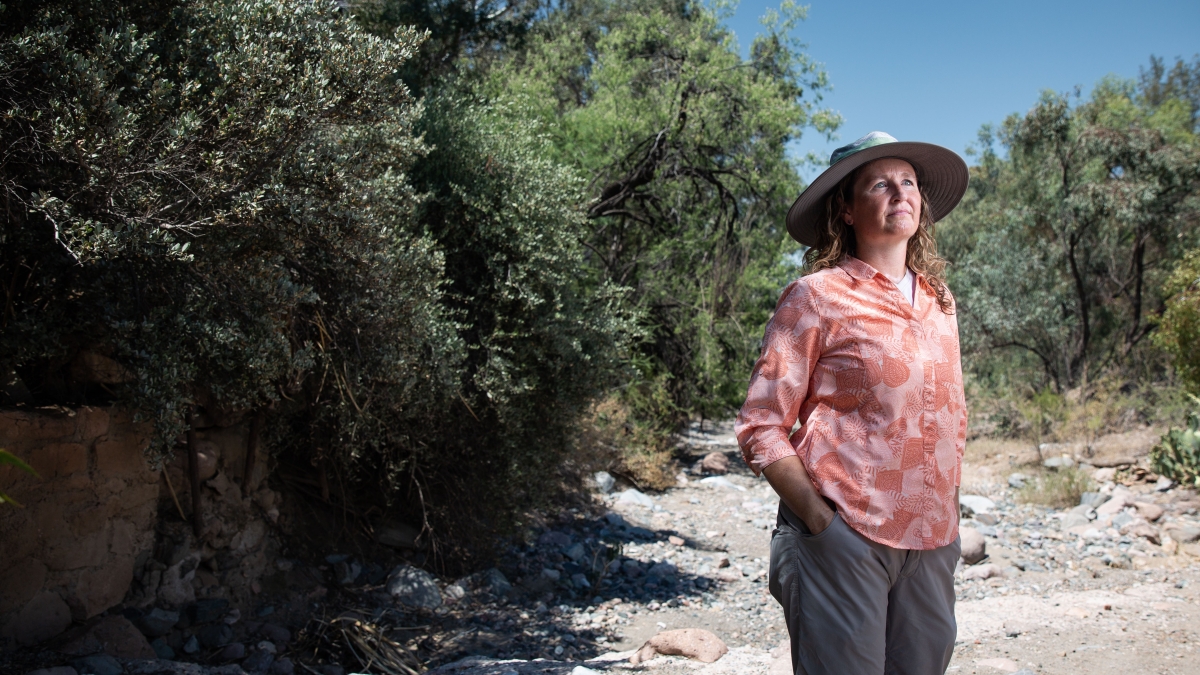An Arizona State University professor said the state’s rivers are only going to see shortages in the future, which will have a direct impact not only on humans, but wildlife and their habitats.
Two factors are driving this: climate change and human population growth.
“The Southwest will face major challenges in the future by needing to balance anthropogenic water consumption with water that nature needs,” said Heather Bateman, an associate professor with ASU’s College of Integrative Arts and Sciences. “We might need to set priorities as a state or region on which ecosystems should hold the right to maintain their hydrologic flows.”
ASU Now spoke to Bateman, a field ecologist who studies terrestrial wildlife such as birds, reptiles, and amphibians, on this troubling development and what it will mean for the future of Arizona’s river system.
Question: How does nature use water?
Answer: Water is rare in the arid southwestern United States. Rivers and their floodplain habitats make up less than 3% of the total land area. These habitats, called riparian areas, are interfaces between aquatic and terrestrial systems. Riparian areas support trees and woody vegetation that require shallow groundwater. These forests offer a cooler and more humid microclimate, compared to the surrounding Sonoran Desert. Most wildlife relies on riparian areas at some point during their life cycle. This means that animals use the habitat for migration or commuting, to find food and mates, and some species will only raise their young there. Several species of fish and wildlife that have state and federal projection are found exclusively in streams and riparian areas. Unfortunately, because these areas have been modified and diminished, species needing these areas have declined in numbers and are of conservation concern.
Q: How is Phoenix’s burgeoning population straining our rivers and ecosystems?
A: Phoenix is the fifth largest city and Maricopa County is among the fastest growing in the U.S. This means that the demand for water by humans will likely increase for consumption, municipal, industrial and agriculture uses. As industry changes and land use changes, water use will also fluctuate. For example, converting an alfalfa field to residential homes will save water, but converting desert to residents will consume more water.
Q: What will this potential shortage do to our state’s riparian system?
A: Having less water in streams means that groundwater in riparian areas will lower and trees and woody vegetation needing this will die back. Sometimes the timing of high flow events is very important. For example, cottonwood and other trees set seeds to be released during the season when water flow is high. These floods scour river banks and deposit the seeds in suitable substrate. Without floods, these plants cannot recruit, or produce the next generation. When these flood-adapted plant species die back, other plants will take their place and a different suite of wildlife will start to use these areas. Our research has found that in highly modified rivers, non-native plants that don't need floods become established. We find lower diversity of lizards, amphibians and small mammals in these modified areas. Interestingly, even intermittent waters are important resources in the desert. If these arroyos and washes don't flow during monsoon or winter rainy seasons, those habitats can also experience decreases in biodiversity.
Q: Are there examples where resource managers have done a good job keeping the state’s rivers flowing?
A: Some natural resource agencies have asked the state for permission to keep water in the stream, sort of a water right, and not be withdrawn for other uses. The process involves documenting how flows in rivers are important for maintaining diverse habitat and wildlife and that this is a beneficial use of water. As I mentioned before, some areas might be worth prioritizing for keeping water in the stream for important areas. Arizona has only two streams with the federal designation of Wild and Scenic. The Wild and Scenic Rivers Act was signed into law over 50 years ago and was used to prioritize areas deemed to have significant natural resource value. In the U.S., less than 1% of our rivers have this protection.
Q: What does this possible shortage mean for future wildlife?
A: When streams become de-watered or lose their high flows, I mentioned that the forest composition can change. Species needing more water will be replaced by more drought-tolerant species. Same can happen with the wildlife. Animals that need plants or water for feeding and nesting will be replaced by species that are more tolerant of a wider range of conditions. These generalist species can be found in other habitats and the uniqueness of riparian areas will decline.
Q: What can Arizona residents do to improve our water and rivers?
A: Go visit these areas. Take a walk along a stream and listen for birds and see if there are flowers and pollinators around. Feel the coolness of these areas as they provide shade from the sun. I find these areas to be inspirational and not only are they good for the wildlife, but they are good for us too. Three streams come into Phoenix, which is why we call it the Valley. These streams are water sources for humans too. Pay attention to how decision-makers handle water issues. For example, how might a border wall that blocks stream flow affect the San Pedro? The headwaters of the San Pedro are in Mexico and the stream flows north into Arizona. This stream also has an important conservation designation. Without headwater flows, there is less water to support vegetation, and less vegetation to support wildlife or future human growth. Besides, it's good for people to connect with nature. I hope that people can see Phoenix as a river city.
Top photo: Heather Bateman, an associate professor with ASU’s College of Integrative Arts and Sciences, stands outside the Boyce Thompson Arboretum in Superior, Arizona. Photo by Deanna Dent/ASU Now
More Science and technology

Podcast explores the future in a rapidly evolving world
What will it mean to be human in the future? Who owns data and who owns us? Can machines think?These are some of the questions pondered on a newly launched podcast titled “Modem Futura.” Co-…

New NIH-funded program will train ASU students for the future of AI-powered medicine
The medical sector is increasingly exploring the use of artificial intelligence, or AI, to make health care more affordable and to improve patient outcomes, but new programs are needed to train…

Cosmic clues: Metal-poor regions unveil potential method for galaxy growth
For decades, astronomers have analyzed data from space and ground telescopes to learn more about galaxies in the universe. Understanding how galaxies behave in metal-poor regions could play a crucial…
